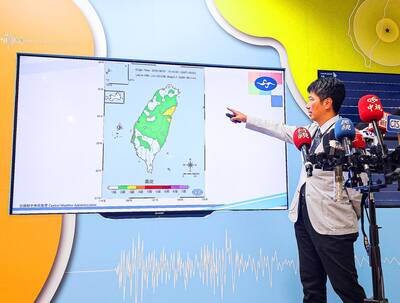Minister of National Defense Wellington Koo (顧立雄) today said the military has a grasp of the situation after reports that a Chinese submarine sank earlier this year.
A senior US defense official, speaking on condition of anonymity, said that China's new first-in-class nuclear-powered attack submarine sank alongside a pier sometime between May and June.
The official said it was not clear what caused it to sink or whether it had nuclear fuel on board at the time.

Photo: Reuters
A Chinese embassy spokesperson in Washington said they had no information to provide.
In Taipei, Koo told reporters that authorities "have a grasp of the situation through multiple intelligence and surveillance methods," but did not elaborate.
China already has the largest navy in the world, with more than 370 ships, and it has embarked on production of a new generation of nuclear-armed submarines.
"In addition to the obvious questions about training standards and equipment quality, the incident raises deeper questions about the PLA's [Chinese People’s Liberation Army’s] internal accountability and oversight of China's defense industry, which has long been plagued by corruption," the US official said.
"It's not surprising that the PLA Navy would try to conceal" the sinking, the official added.
In June, pictures appeared online of a Chinese nuclear submarine surfacing in the Taiwan Strait near Taiwan fishers.
The Chinese submarine news was first reported by the Wall Street Journal.
A series of satellite images from Planet Labs from June appear to show cranes at the Wuchang shipyard, where the submarine would have been docked.
As of 2022, China had six nuclear-powered ballistic missile submarines, six nuclear-powered attack submarines and 48 diesel-powered attack submarines, according to a Pentagon report on China's military.
That submarine force is expected to grow to 65 by next year and 80 by 2035, the US Department of Defense has said.

Aftershocks from a magnitude 6.2 earthquake that struck off Yilan County at 3:45pm yesterday could reach a magnitude of 5 to 5.5, the Central Weather Administration (CWA) said. Seismological Center technical officer Chiu Chun-ta (邱俊達) told a news conference that the epicenter of the temblor was more than 100km from Taiwan. Although predicted to measure between magnitude 5 and 5.5, the aftershocks would reach an intensity of 1 on Taiwan’s 7-tier scale, which gauges the actual effect of an earthquake, he said. The earthquake lasted longer in Taipei because the city is in a basin, he said. The quake’s epicenter was about 128.9km east-southeast

The Taipei Summer Festival is to begin tomorrow at Dadaocheng Wharf (大稻埕), featuring four themed firework shows and five live music performances throughout the month, the Taipei Department of Information and Tourism said today. The festival in the city’s Datong District (大同) is to run until Aug. 30, holding firework displays on Wednesdays and the final Saturday of the event. The first show is scheduled for tomorrow, followed by Aug. 13, 20 and 30. To celebrate the 30th anniversary of Disney Pixar's movie Toy Story, the festival has partnered with Walt Disney Co (Taiwan) to host a special themed area on

BE CAREFUL: The virus rarely causes severe illness or death, but newborns, older people and those with medical conditions are at risk of more severe illness As more than 7,000 cases of chikungunya fever have been reported in China’s Guangdong Province this year, including 2,892 new cases last week, the Centers for Disease Control (CDC) yesterday said it is monitoring the situation and considering raising the travel notice level, which might be announced today. The CDC issued a level 1 travel notice, or “watch,” for Guangdong Province on July 22, citing an outbreak in Foshan, a manufacturing hub in the south of the province, that was reported early last month. Between July 27 and Saturday, the province reported 2,892 new cases of chikungunya, reaching a total of 7,716

The New Taipei City Government today warned about the often-overlooked dangers of playing in water, and recommended safe swimming destinations to cool off from the summer heat. The following locations in the city as safe and fun for those looking to enjoy the water: Chienshuiwan (淺水灣), Baishawan (白沙灣), Jhongjiao Bay (中角灣), Fulong Beach Resort (福隆海水浴場) and Sansia District’s (三峽) Dabao River (大豹溪), New Taipei City Tourism and Travel Department Director-General Yang Tsung-min (楊宗珉) said. Outdoor bodies of water have variables outside of human control, such as changing currents, differing elevations and environmental hazards, all of which can lead to accidents, Yang said. Sudden